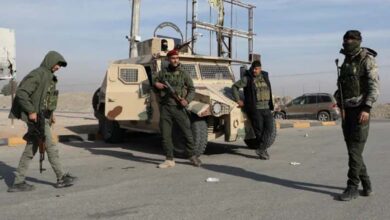Sudan Stuck Between War and Climate Change: Blockades, Diseases, and Drought

Climate change in Sudan results in a shortage of drinking water, exacerbated by the ongoing war in the country for over a year.
Issa, a head of a family living in the “Sortony” displaced persons camp in North Darfur state, which houses more than 65,000 people, tells Agence France-Presse: “Since the beginning of the war (April 2023), two of my children walk 14 kilometers daily to fetch water.”
Darfur, a vast region, hosts the largest number of displaced persons centers in the country. The recent war has increased the number of internally displaced persons to nearly 10 million. The water shortage adds to many other crises that Sudanese people face in their daily lives.
In Sudan, where decades of conflicts have destroyed infrastructure, climate change manifests in heavy rains followed by heatwaves with temperatures reaching 50 degrees Celsius in summer. On April 15, 2023, when a new war erupted between the army led by Abdel Fattah al-Burhan and the Rapid Support Forces led by Mohamed Hamdan, diplomats and humanitarian workers quickly left Sudan, significantly reducing aid to vulnerable groups.
This happened in Sortony.
Issa explains that an Italian humanitarian organization responsible for drinking water stations in the camp ceased operations due to the war.
But even before the recent conflict, the United Nations Office for the Coordination of Humanitarian Affairs (OCHA) had warned that “26% of Sudan’s population walks more than 50 minutes to find water, exposing themselves to security risks, especially women.”
Rain and Groundwater
In the village of Shagra, also in Darfur, where 40,000 displaced people live, water shortage complaints are frequent, according to Adam Ragal, spokesperson for the Coordination of Displaced Persons.
Displaced persons, mostly women and children, wait their turn to get water while sheltering from the scorching sun under some trees.
Ragal states: “After the war and despite the dwindling water sources, people queue up to 300 meters to get drinking water.” Except for areas near rivers like the Nile, Sudan’s residents rely on two water sources: rain and groundwater.
Regarding rain, the broader Horn of Africa region, including Sudan, has experienced the worst drought in its history since the end of 2020.
Five consecutive seasons of inadequate rainfall have led to the death of millions of livestock and the destruction of crops, forcing millions of people to leave their areas in search of water and food elsewhere. As for groundwater, the war-induced fuel shortage hampers water extraction, especially in areas far from fresh water sources like Darfur and Gedaref state in eastern Sudan.
A European diplomat familiar with Sudan, who requested anonymity, told AFP: “Even if water is available, if the pump is broken or if fuel is not available, you won’t be able to access it.”
He explains: “The water is there, but it is over 60 meters deep, which makes accessing it with a manual pump difficult.”
The diplomat mentioned El-Fasher, the capital of North Darfur state, with a population of 1.5 million, where violent clashes have been ongoing since the first week of May, with severe blockades and a shortage of water and food.
He adds: “If the Rapid Support Forces do not allow fuel deliveries, water stations will stop working, and a large part of the population will simply not have water.”
Blockades and Diseases
According to Médecins Sans Frontières (MSF), “at least 192 people have been killed and more than 1,230 injured since May 10 in El-Fasher.”
MSF’s medical officer in Darfur, Adam Ahmed Shumo, says: “Most people have left their homes for the camps, especially the Zamzam camp, but they face major difficulties in obtaining water and increased living costs due to insecurity.”
UNICEF has warned that armed clashes over the “Golo” water reservoir in western El-Fasher “threaten to cut off safe and sufficient water for about 270,000 people in El-Fasher and surrounding areas.”
In Khartoum, controlled by the Rapid Support Forces, entire neighborhoods are deprived of water.
A volunteer from one of the resistance committees, groups throughout Sudan that organized pro-democracy demonstrations before the recent war, told AFP that the Soba water treatment plant in Khartoum, serving a large number of capital residents, “has been out of service since the start of the war.”
He adds that since then, residents have been forced to buy “untreated water transported by horse-drawn carts, exposing them to diseases.”
He explains: “We spent 6,000 Sudanese pounds (about 5 dollars) daily to buy water.” Salah, another volunteer, told AFP that entire neighborhoods in Bahri city, north of the capital, “have been without drinking water for a year.”
On the Red Sea in Port Sudan, where pro-army ministries and UN offices are located, a resident, Sadiq Hussein, told AFP: “Water is also a major problem,” expressing his concern as summer approaches.
With the war and the massive influx of displaced people into the region, residents now buy fresh water transported by carts.
Taha Taher, an environmental health expert, states: “Water pollution needs to be monitored,” but laments that this is not happening, especially as “the problem is worsening” with the current large population.
Over nearly a year, from April 2023 to March 2024, the Sudanese Ministry of Health recorded 11,000 cases of cholera in several regions of the country.
The European diplomat sums up the situation by saying: “The health system has collapsed, and people are drinking contaminated water.”
A volunteer from one of the resistance committees, groups throughout Sudan that used to organize pro-democracy demonstrations before the recent war, told AFP that the Soba water treatment plant in Khartoum, which serves a large number of the capital’s residents, “has been out of service since the start of the war.”
He adds that since then, citizens have been forced to buy “untreated water transported by horse-drawn carts, exposing them to diseases.”
He explains: “We spent 6,000 Sudanese pounds (about 5 dollars) daily to buy water.” Salah, another volunteer, told AFP that entire neighborhoods in Bahri city, north of the capital, “have been without drinking water for a year.”
On the Red Sea in Port Sudan, where pro-army ministries and UN offices are located, a resident, Sadiq Hussein, told AFP: “Water is also a major problem,” expressing his concern as summer approaches.
With the war and the massive influx of displaced people into the region, residents now buy fresh water transported by carts.
Taha Taher, an environmental health expert, states: “Water pollution needs to be monitored,” but laments that this is not happening, especially as “the problem is worsening” with the current large population.
Over nearly a year, from April 2023 to March 2024, the Sudanese Ministry of Health recorded 11,000 cases of cholera in several regions of the country.
The European diplomat sums up the situation by saying: “The health system has collapsed, and people are drinking contaminated water.”












